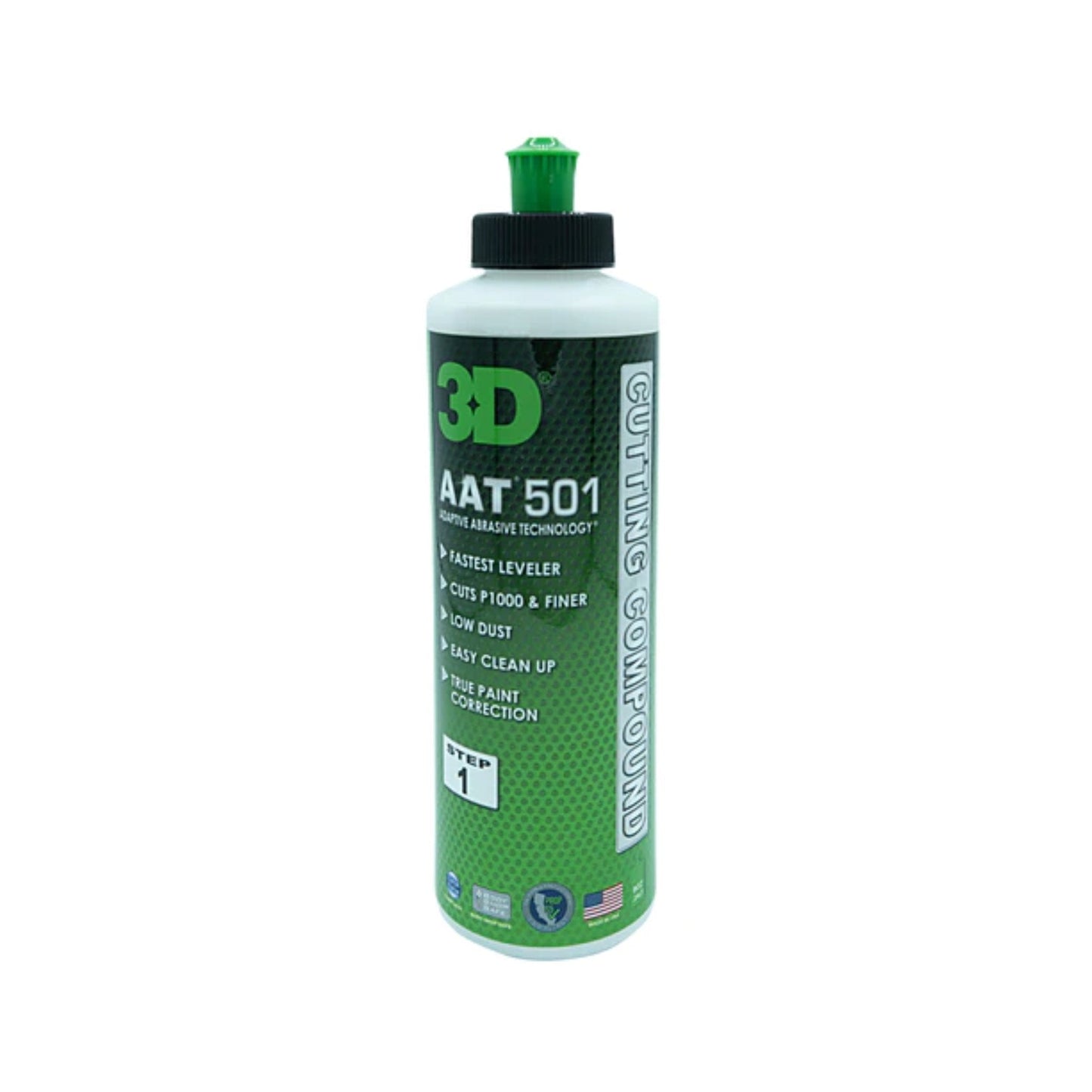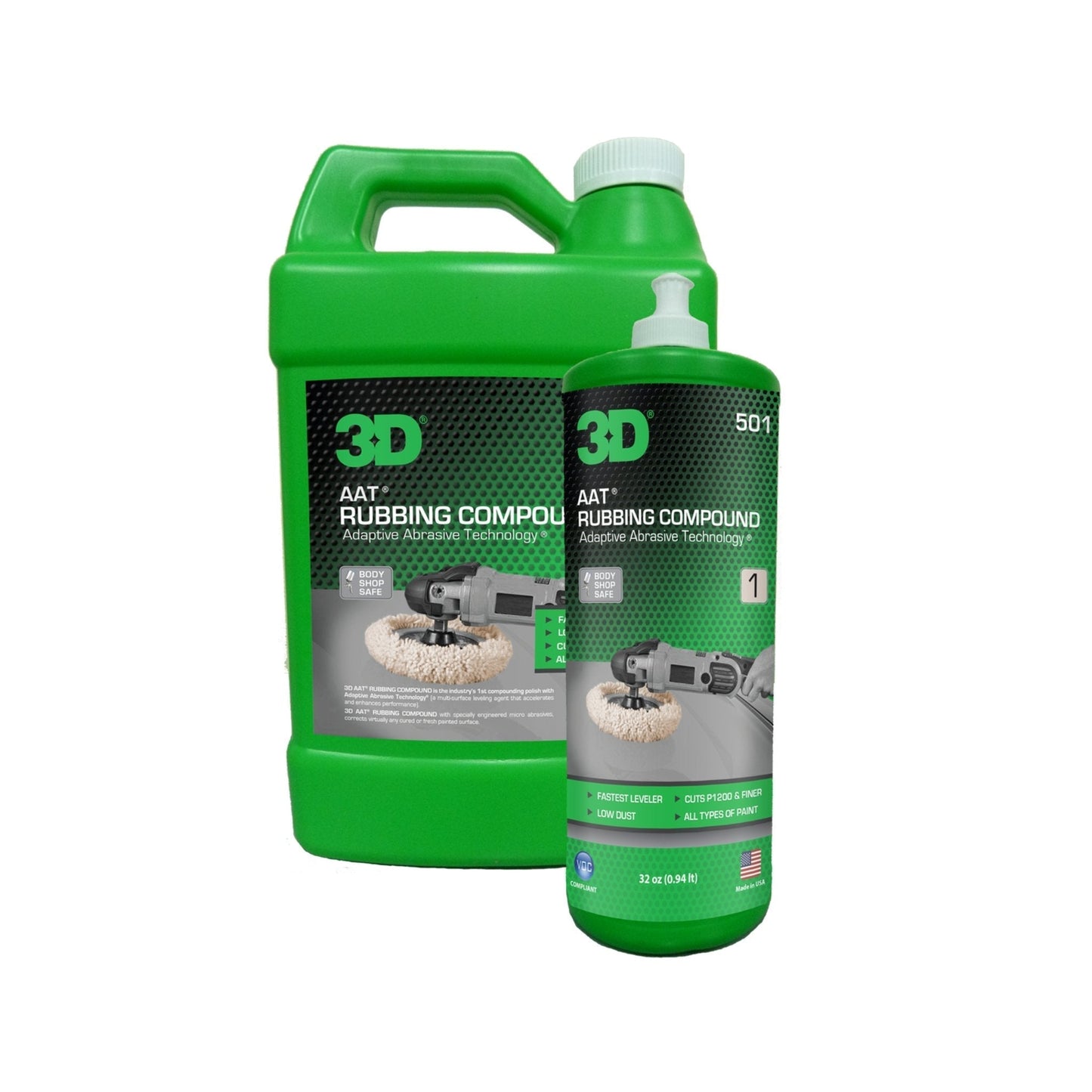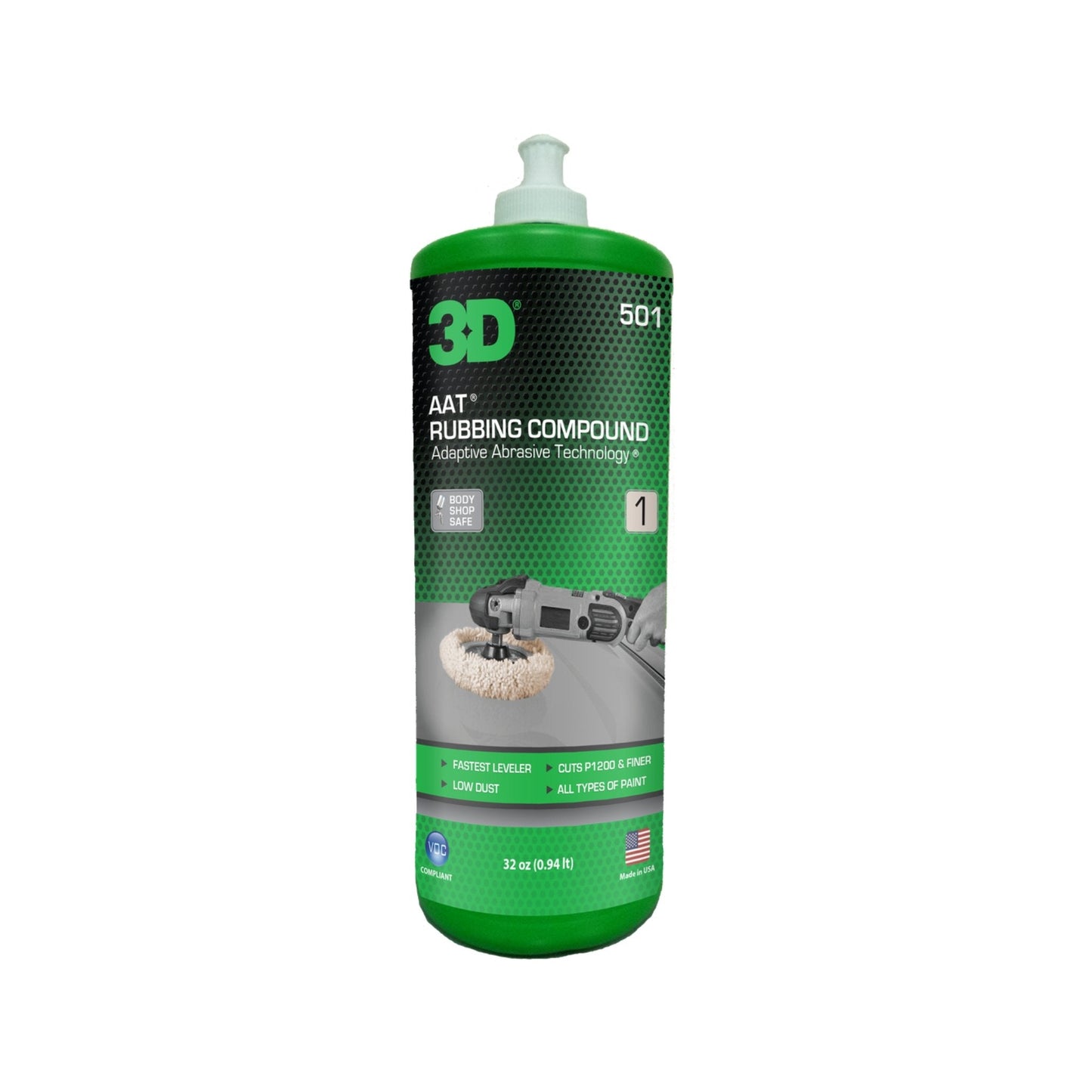3D
3D AAT CUTTING COMPOUND
3D AAT CUTTING COMPOUND
Couldn't load pickup availability
-
3D AAT 501 Cutting Compound is the first part in a two-part system for use in body shops to cut and finish after sanding. Body shops are considered high-speed or production shops, the collision repair must be made in a timely manner followed by paint work and final polishing steps. Body shop technicians need a compound that works fast and delivers true results, that is the results you see are the results you get.
Many compounds mask scratches and swirls with fillers or oils – we don’t make these kinds of products here at 3D. What you see is what you get – true paint correction with zero hiding.
3D AAT 501 Cutting Compound is our entry level compound. While it’s our entry level compound and the price reflects this, it’s as good, and in most cases better, than any other brand of compound. If your shop is looking for an inexpensive fast cutting compound that works better than the usual suspects, then try 3D AAT 501 Cutting Compound.
Then, after you discover how great our entry level compound is – next time treat yourself to the very best in fast cutting abrasive technology and get a bottle of 3D ACA 510 Premium Rubbing Compound. This top shelf compound costs more to manufacture but after you use it one time, you’ll see why it costs more and you’ll also order it again and again and again – it’s that good.
3D on the outside of the bottle means you can trust the product on the inside of the bottle.
What is it? - A body shop safe, silicone-free, water based pro grade fast cutting compound for use on automotive paints in in body shops environments. Can be used with any rotary or orbital polisher. Can also be used with both wool and foam pads.
What does it do? - 3D AAT 501 Cutting Compound is formulated and intended for use in body shops to remove sanding marks after wet sanding. It can also be used by detailers for paint correction including removing deep scratches, water spots, swirls, and oxidation. 3D AAT 501 Cutting Compound levels automotive paint surfaces to create a more perfect finish
When do you use it? - After wet sanding paint to remove the sanding marks or anytime you need to perform paint correction to remove serious and/or deep swirls, scratches, water spots or oxidation and prep the paint for the polishing step.
Why use 3D AAT 501 Cutting Compound over other options? - 3D AAT 501 Cutting Compound contains ZERO crystalline silica. This is very important. Historically, and to this day, many compounds and polishes contain this hazardous mineral.
Inhaling crystalline silica can lead to serious, sometimes fatal illnesses including silicosis, lung cancer, tuberculosis (in those with silicosis), and chronic obstructive pulmonary disease (COPD). In addition, silica exposure has been linked to other illnesses including renal disease and other cancers.
Here at 3D Products, our goal is to not only create world class products that are environmentally green but also completely safe for our customers. Our compounds, polishes and all-in-one products are all 100% free of any crystalline silica to keep you safe.
Crystalline Silica is nothing to mess around with, if you breathe it into your lungs chances are really high it will cause life-long health issues and worse. Before you purchase any brand of compound, polish, or all-in-one, make sure the label and any accompanying information clearly states the product is safe and does not contain crystalline silica. You can trust the 3D brand; we look out for you.
- FASTER cutting compound for removing sanding marks and other serious paint defects like swirls, scratches, water spots and oxidation.
- Adaptive Abrasive Technology – Provides both mechanical and chemical cutting action.
- Pad independent – use with cutting or polishing foam or wool pads.
- Removes down to P1000 sanding marks.
- Works with any rotary or orbital polisherplus can be used in full sun.
- Body shop safe – Fresh paint safe – Silicone free!
- Does NOT contain OSHA regulated Crystalline Silica! - HUMAN SAFE
- Water-based – No harsh solvents or foul odors!
- Wipes off easy! – Won’t clog buffing pads –– Competitive pricing.
- 3D’s Green Earth Technology – Biodegradable, Prop 65 and V.O.C. compliant.
Directions:
IMPORTANT: Always work on a cool clean surface in the shade. 3D AAT 501 cuts fast. Be sure to understand the paint you are working on before starting. This compound was originally developed for working on fresh, custom paint work in body shop situations where the technician knows how much paint is being sprayed onto the panels or entire car body. If you’re a detailer working on customer cars, remember factory paint is thin. Always do a Test Spot and use the least aggressive process to get the job done.
Body Shops – Using a rotary polisher
Step 1: Prepare the surface by sanding the paint with the sanding paper of your choice.
Step 2: Attach preferred foam or wool cutting pad to backing plate on rotary polisher and set speed setting to low or medium.
Step 3: Apply 4-5 dime sized drops of product onto the center of the face of buffing pad. Press the face of the pad against a body panel, turn the polisher on and spread the product over the area to be worked, about 2’ by 2’.
Step 4: After spreading polish over area to be worked - turn polisher to a medium to high speed and begin making overlapping passes. Move polisher over paint using a slow to medium arm speed. Monitor defect removal as you buff. Once paint defects are removed to your satisfaction, stop buffing and remove any excess product using a clean, soft microfiber towel.
Detail Shops/Enthusiasts – Using an orbital polisher
Step 1: Prepare the surface by first washing, drying, and removing any above surface bonded contaminants using detailing clay or a clay substitute.
Step 2: Attach preferred foam, microfiber or wool cutting pad to backing plate on orbital polisher and set speed setting to low or medium.
Step 3: Apply 4-5 dime sized drops of product onto the center of the face of buffing pad. Press the face of the pad against a body panel, turn the polisher on and spread the product over the area to be worked, about 2’ by 2’.
Step 4: After spreading polish over area to be worked - turn polisher to a medium to high speed and begin making overlapping passes. Move polisher over paint using a slow to medium arm speed. Monitor defect removal as you buff. Once paint defects are removed to your satisfaction, stop buffing and remove any excess product using a clean, soft microfiber towel.
Share




SUBSCRIBE TO OUR EMAILS
Be the first to know about new collections and exclusive offers.




